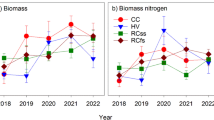Summary
Under some conditions the plow down of forage legumes increases the yield of subsequent crops, which is usually caused by improved soil N. However, better soil structure is also a contributing factor. Three experiments were conducted to measure the effect of legume plow down on the yield of subsequent corn crops grown at the Ottawa Research Station (ORS), Ottawa, Canada. In all experiments, corn yields were not affected by legume species, legume cultivars, and/or planting methods. Corn yields from barley plots receiving 0, 60, or 120 kg N ha−1 did not differ until two years after establishment in one experiment and three years in another. The data from these experiments indicated that soil N was high at the ORS, which may inhibit N2-fixation by forage legumès in the establishment year. Therefore, legume plow down was not beneficial to subsequent crops under these conditions.
Two other experiments were conducted to measure the effect of legume plow down on the yield of subsequent barley crops. In both experiments, barley yields in the field were not affected by legume type or legume seeding density. Greenhouse and field data indicated that the two cuts with removal strategy benefitted the most to succeeding crops. Data from the greenhouse test indicated that soil N levels were not low in the establishment year, and that some cultivars improved soil fertility more than others.
Similar content being viewed by others
References
Bartlett M S 1978 Nearest neighbour models in the analysis of field experimets. J.R. Statist. Soc. B 40, 147–174.
Bowren K E, Cooke D A and Downey R K 1969 Yield of dry matter and nitrogen from tops and roots of sweetclover, alfalfa and red clover at five stages of growth. Can. J. Plant Sci. 49, 61–68.
Broadbent F E, Nakashima T and Chang G Y 1982 Estimation of nitrogen fixation by isotope dilution in field and greenhouse experiments. Agron. J. 74, 625–628.
Carder A C and Hanson A A 1951 Sweet clover and the grey-wooded soils of the Peace River region. Sci. Agr. 31, 325–344.
Groya F L and Sheaffer C C 1985 Nitrogen from forage legumes: Harvest and tillage effects. Agron. J. 77, 105–109.
Heichel G H, Barnes D K, Vance C P and Henjum K I 1984 N2 fixation, and N and dry matter partitioning during a 4-year alfalfa stand. Crop. Sci. 24, 811–815.
Hoyt P B and Hennig A M F 1971 Effect of alfalfa and grasses on yield of subsequent wheat crops and some chemical properties of a gray wooded soil. Can. J. Soil Sci. 62, 177–183.
Hoyt P B and Leitch R H 1983 Effects of forage legume species on soil moisture, nitrogen and yield of succeeding barley crops. Can. J. Soil Sci. 62, 125–136.
Kroontje W and Kher W R 1956 Legume top and root yields in the year of seeding and subsequent barley yield. Agron. J. 48, 128–131.
LaRue T A and Patterson T G 1981 How much nitrogen do legumes fix? Adv. Agron. 34, 15–38.
Lyon T L and Bizzell J A 1933 Nitrogen accumulation in soil as influenced by the cropping system. J. Am. Soc. Agron. 25, 266–272.
Mazurak A P, Cosper H R and Rhoades H F 1955 Rate of water entry into an irrigated chestnut soil as affected by 39 years of cropping and manurial practices. Agron. J. 47, 490–493.
Pumphrey F V and Koehler F E 1958 Forage and root growth of five sweetclover varieties and their influence on two following corn crops. Agron. J. 50, 323–326.
Singh K K and Awasthi O P 1978. Maintenance of soil fertility in the hills with incorporation of legumes in cropping sequences. Ind. J. Agric. Sci. 48, 41–46.
Spratt E D 1966 Fertility of a chernozemic clay soil after 50 years of cropping with and without forage crops in the rotation. Can. J. Soil Sci. 46, 207–212.
Stevenson F J 1982 Nitrogen in Agricultural Soils. American Society of Agronomy, Inc., Madison, WI. 940 p.
Stickler F C and Johnson I J 1959 The influence of clipping on dry matter and nitrogen production of legume green manures. Agron. J. 51, 137–138.
Toogood J A and Lynch D L 1959 Effect of cropping systems and fertilizers on mean weight-diameter of aggregates of Breton plot soils. Can. J. Soil. Sci. 39, 151–156.
Wyatt F A 1934 The necessity for growing legumes on gray wooded soils. Sci. Agric. 14, 327–335.
Author information
Authors and Affiliations
Rights and permissions
About this article
Cite this article
Faris, M.A., Smith, D.L. & Coulman, B.E. Plow down effects of different forage legume species, cultivars, cutting strategies and seeding rates on the yields of subsequent crops. Plant Soil 95, 419–430 (1986). https://doi.org/10.1007/BF02374622
Received:
Revised:
Issue Date:
DOI: https://doi.org/10.1007/BF02374622




